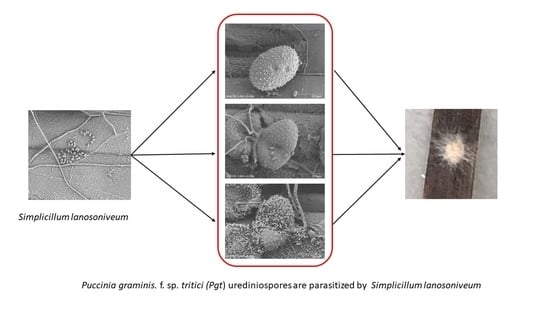Evaluating the Utility of Simplicillium lanosoniveum, a Hyperparasitic Fungus of Puccinia graminis f. sp. tritici, as a Biological Control Agent against Wheat Stem Rust
Abstract
1. Introduction
2. Materials and Methods
2.1. Isolation and Purification of Hyperparasitic Fungi
2.2. Morphological Observations of Hyperparasitic Fungi
2.3. SEM of Stem Rust Fungi and Hyperparasitic Fungi
2.4. Molecular Identification of Hyperparasitic Fungi
2.5. Phylogenetic Analysis
2.6. Hyperparasitic Fungal Inhibition Experiment
2.7. Urediniospore Germination Inhibition Experiment
3. Results and Analysis
3.1. Morphological Observations of Hyperparasitic Fungi
3.2. Molecular Identification of Hyperparasitic Fungi
3.3. Pathogenicity Test to Confirm Hyperparasitism: S. lanosoniveum Parasitizing Pgt
3.4. Urediniospore Production Inhibition Experiment
3.5. SEM of Stem Rust Fungi and Hyperparasitic Fungi
4. Discussion
5. Conclusions
Author Contributions
Funding
Institutional Review Board Statement
Informed Consent Statement
Data Availability Statement
Conflicts of Interest
References
- Lorrain, C.; Goncalves Dos Santos, K.C.; Germain, H.; Hecker, A.; Duplessis, S. Advances in understanding obligate biotrophy in rust fungi. New Phytol. 2019, 222, 1190–1206. [Google Scholar] [CrossRef]
- Cao, Y.; Si, B.; Zhu, G.; Xu, X.; Li, W.; Chen, S.; Zhao, J.; Li, T. Race and virulence of asexual and sexual populations of Puccinia graminis f. sp. tritici in China from 2009 to 2015. Eur. J. Plant Pathol. 2018, 153, 545–555. [Google Scholar] [CrossRef]
- Jaswal, R.; Rajarammohan, S.; Dubey, H.; Sharma, T.R. Smut fungi as a stratagem to characterize rust effectors: Opportunities and challenges. World J. Microbiol. Biotechnol. 2020, 36, 150. [Google Scholar] [CrossRef]
- Zhang, H.; He, M.; Fan, X.; Dai, L.; Zhang, S.; Hu, Z.; Wang, N. Isolation, Identification and Hyperparasitism of a Novel Cladosporium cladosporioides Isolate Hyperparasitic to Puccinia striiformis f. sp. tritici, the Wheat Stripe Rust Pathogen. Biology 2022, 11, 892. [Google Scholar] [CrossRef]
- Zheng, L.; Zhao, J.; Liang, X.; Zhan, G.; Jiang, S.; Kang, Z. Identification of a Novel Alternaria alternata Strain Able to Hyperparasitize Puccinia striiformis f. sp. tritici, the Causal Agent of Wheat Stripe Rust. Front. Microbiol. 2017, 8, 71. [Google Scholar] [CrossRef]
- Vivas, J.M.S.; Silveira, S.F.; Mussi-Dias, V.; Santos, P.H.D.; Ramos, G.K.S.; Santos, P.R.; Almeida, R.N. Sensitivity of hyperparasitic fungi to alternative products for use in the control of papaya black spot. Braz. J. Biol. 2021, 81, 27–36. [Google Scholar] [CrossRef]
- Ward, N.A.; Robertson, C.L.; Chanda, A.K.; Schneider, R.W. Effects of Simplicillium lanosoniveum on Phakopsora pachyrhizi, the Soybean Rust Pathogen, and Its Use as a Biological Control Agent. Phytopathology 2012, 102, 749–760. [Google Scholar] [CrossRef]
- Wilson, A.; Cuddy, W.S.; Park, R.F.; Harm, G.F.S.; Priest, M.J.; Bailey, J.; Moffitt, M.C. Investigating hyperparasites as potential biological control agents of rust pathogens on cereal crops. Australas. Plant Pathol. 2020, 49, 231–238. [Google Scholar] [CrossRef]
- Martins, S.J.; Soares, A.C.; Medeiros, F.H.V.; Santos, D.B.C.; Pozza, E.A. Contribution of host and environmental factors to the hyperparasitism of coffee rust under field conditions. Australas. Plant Pathol. 2015, 44, 605–610. [Google Scholar] [CrossRef]
- Nasini, G.; Arnone, A.; Assante, G.; Bava, A.; Moricca, S.; Ragazzi, A. Secondary mould metabolites of Cladosporium tenuissimum, a hyperparasite of rust fungi. Phytochemistry 2004, 65, 2107–2111. [Google Scholar] [CrossRef]
- Torres, D.E.; Rojas-Martinez, R.I.; Zavaleta-Mejia, E.; Guevara-Fefer, P.; Marquez-Guzman, G.J.; Perez-Martinez, C. Cladosporium cladosporioides and Cladosporium pseudocladosporioides as potential new fungal antagonists of Puccinia horiana Henn., the causal agent of chrysanthemum white rust. PLoS ONE 2017, 12, e0170782. [Google Scholar] [CrossRef]
- Wang, N.; Fan, X.; Zhang, S.; Liu, B.; He, M.; Chen, X.; Tang, C.; Kang, Z.; Wang, X. Identification of a Hyperparasitic Simplicillium obclavatum Strain Affecting the Infection Dynamics of Puccinia striiformis f. sp. tritici on Wheat. Front. Microbiol. 2020, 11, 1277. [Google Scholar] [CrossRef]
- Sun, J.-Z.; Liu, X.-Z.; McKenzie, E.H.C.; Jeewon, R.; Liu, J.-K.; Zhang, X.-L.; Zhao, Q.; Hyde, K.D. Fungicolous fungi: Terminology, diversity, distribution, evolution, and species checklist. Fungal Divers. 2019, 95, 337–430. [Google Scholar] [CrossRef]
- Zhan, G.; Tian, Y.; Wang, F.; Chen, X.; Guo, J.; Jiao, M.; Huang, L.; Kang, Z. A novel fungal hyperparasite of Puccinia striiformis f. sp. tritici, the causal agent of wheat stripe rust. PLoS ONE 2014, 9, e111484. [Google Scholar] [CrossRef]
- Moricca, S.; Ragazzi, A.; Mitchelson, K.R.; Assante, G. Antagonism of the Two-Needle Pine Stem Rust Fungi Cronartium flaccidum and Peridermium pini by Cladosporium tenuissimum In Vitro and In Planta. Phytopathology 2001, 91, 457–468. [Google Scholar] [CrossRef]
- Wu, X.; Bian, Q.; Lin, Q.; Sun, Q.; Ni, X.; Xu, X.; Qiu, Y.; Xuan, Y.; Cao, Y.; Li, T. Sensitivity of Puccinia graminis f. sp. tritici Isolates from China to Triadimefon and Cross-Resistance Against Diverse Fungicides. Plant Dis. 2020, 104, 2082–2085. [Google Scholar] [CrossRef]
- White, T.J. Amplification and direct sequencing of fungal ribosomal RNA genes for phylogenetics. PCR Protoc. A Guide Methods Appl. 1990, 18, 315–322. [Google Scholar]
- Zhao, J.; Wang, X.J.; Chen, C.Q.; Huang, L.L.; Kang, Z.S. A PCR-Based Assay for Detection of Puccinia striiformis f. sp. tritici in Wheat. Plant Dis. 2007, 91, 1669–1674. [Google Scholar] [CrossRef][Green Version]
- Kumar, S.; Stecher, G.; Li, M.; Knyaz, C.; Tamura, K. MEGA X: Molecular Evolutionary Genetics Analysis across Computing Platforms. Mol. Biol. Evol. 2018, 35, 1547–1549. [Google Scholar] [CrossRef]
- Dominic, M.; Marthamakobe. Biological control of cashew powdery mildew using Ampelomyces quisqualis Ces. J. Biol. Control. 2017, 30, 15591. [Google Scholar] [CrossRef]
- Sallam, N.M.A.; Eraky, A.M.I.; Sallam, A. Effect of Trichoderma spp. on Fusarium wilt disease of tomato. Mol. Biol. Rep. 2019, 46, 4463–4470. [Google Scholar] [CrossRef]
- Kiani, T.; Mehboob, F.; Hyder, M.Z.; Zainy, Z.; Xu, L.; Huang, L.; Farrakh, S. Control of stripe rust of wheat using indigenous endophytic bacteria at seedling and adult plant stage. Sci. Rep. 2021, 11, 14473. [Google Scholar] [CrossRef]
- Wei, D.P.; Wanasinghe, D.N.; Hyde, K.D.; Mortimer, P.E.; Xu, J.; Xiao, Y.P.; Bhunjun, C.S.; To-Anun, C. The genus Simplicillium. MycoKeys 2019, 60, 69–92. [Google Scholar] [CrossRef]
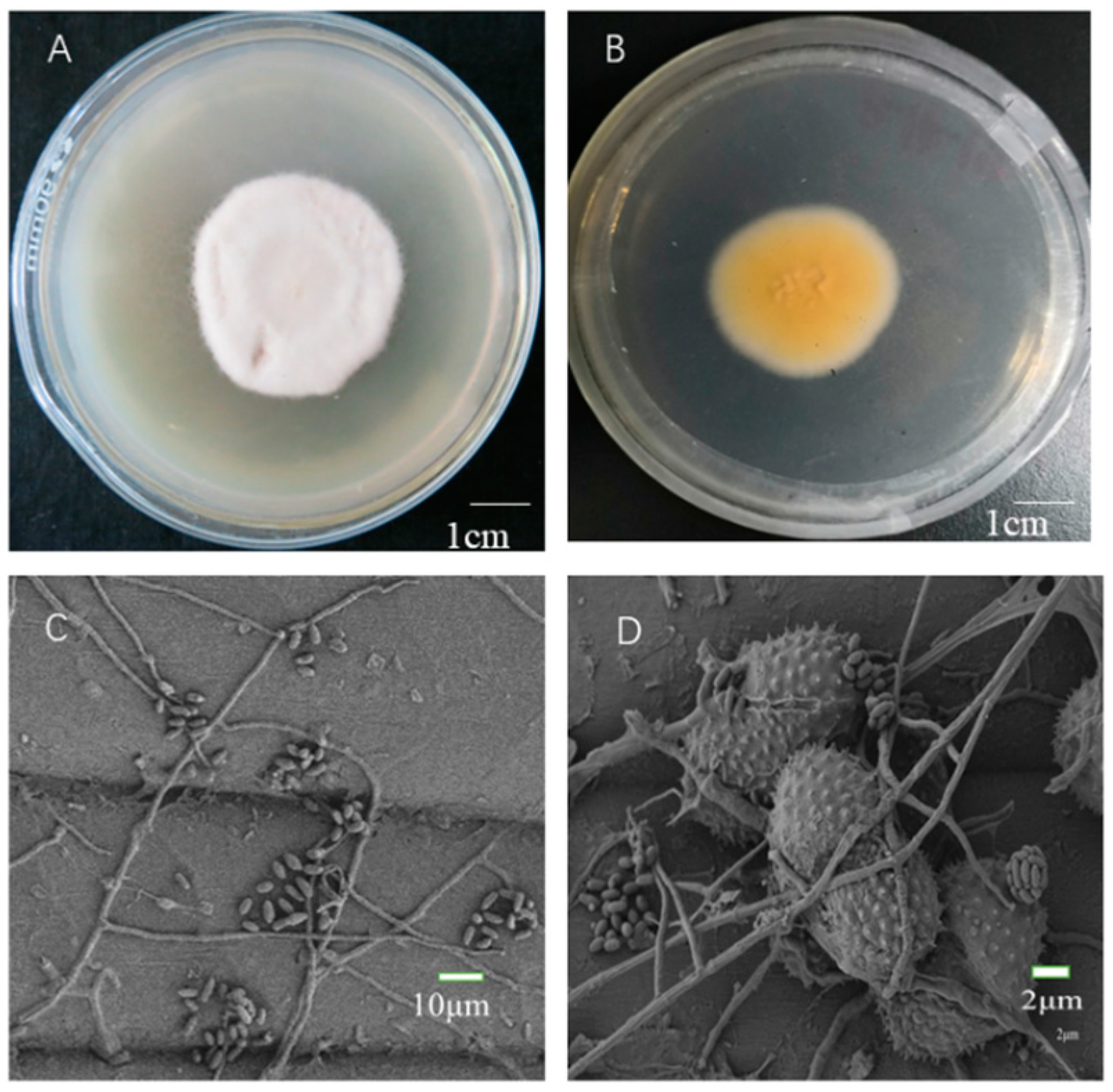
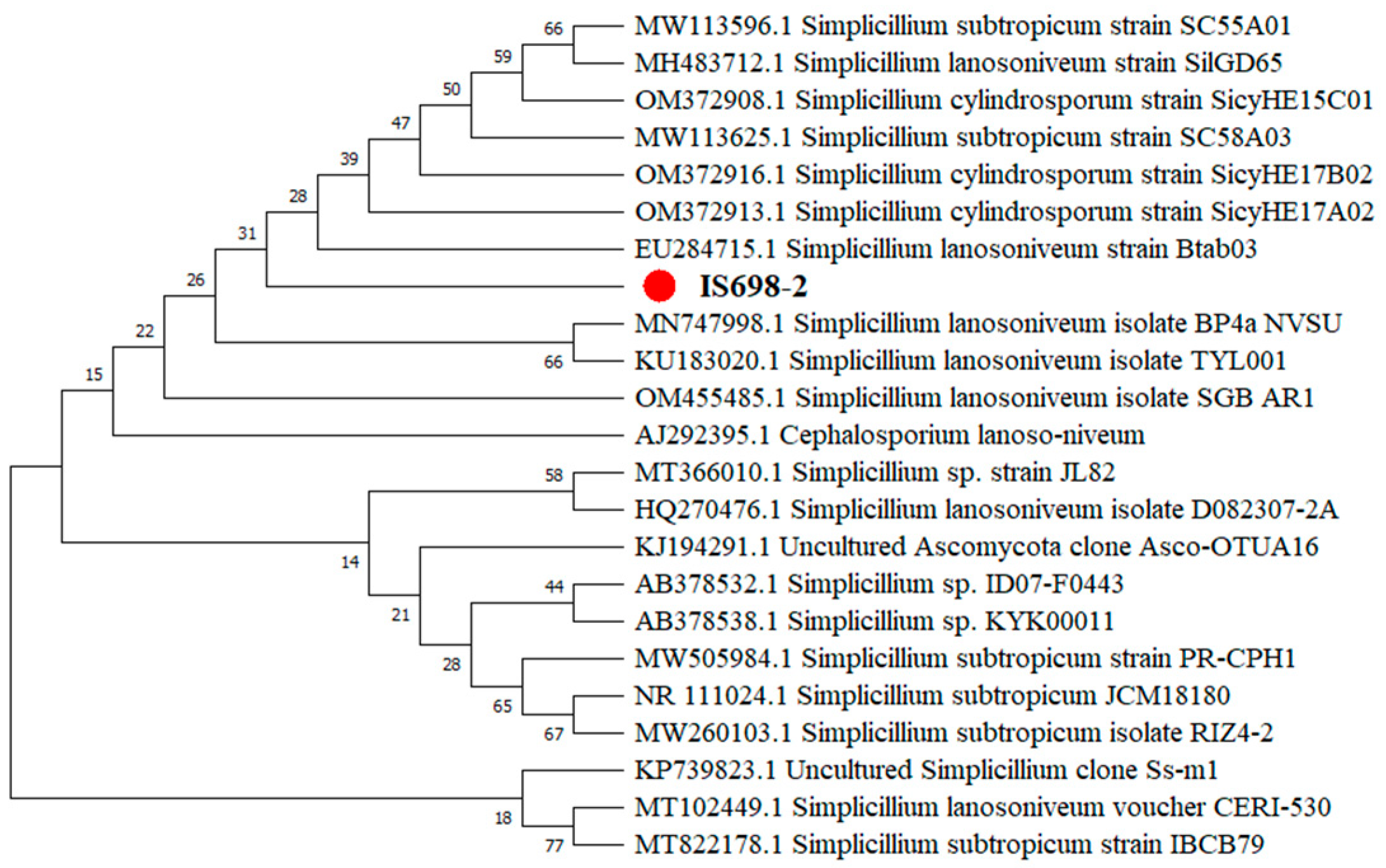
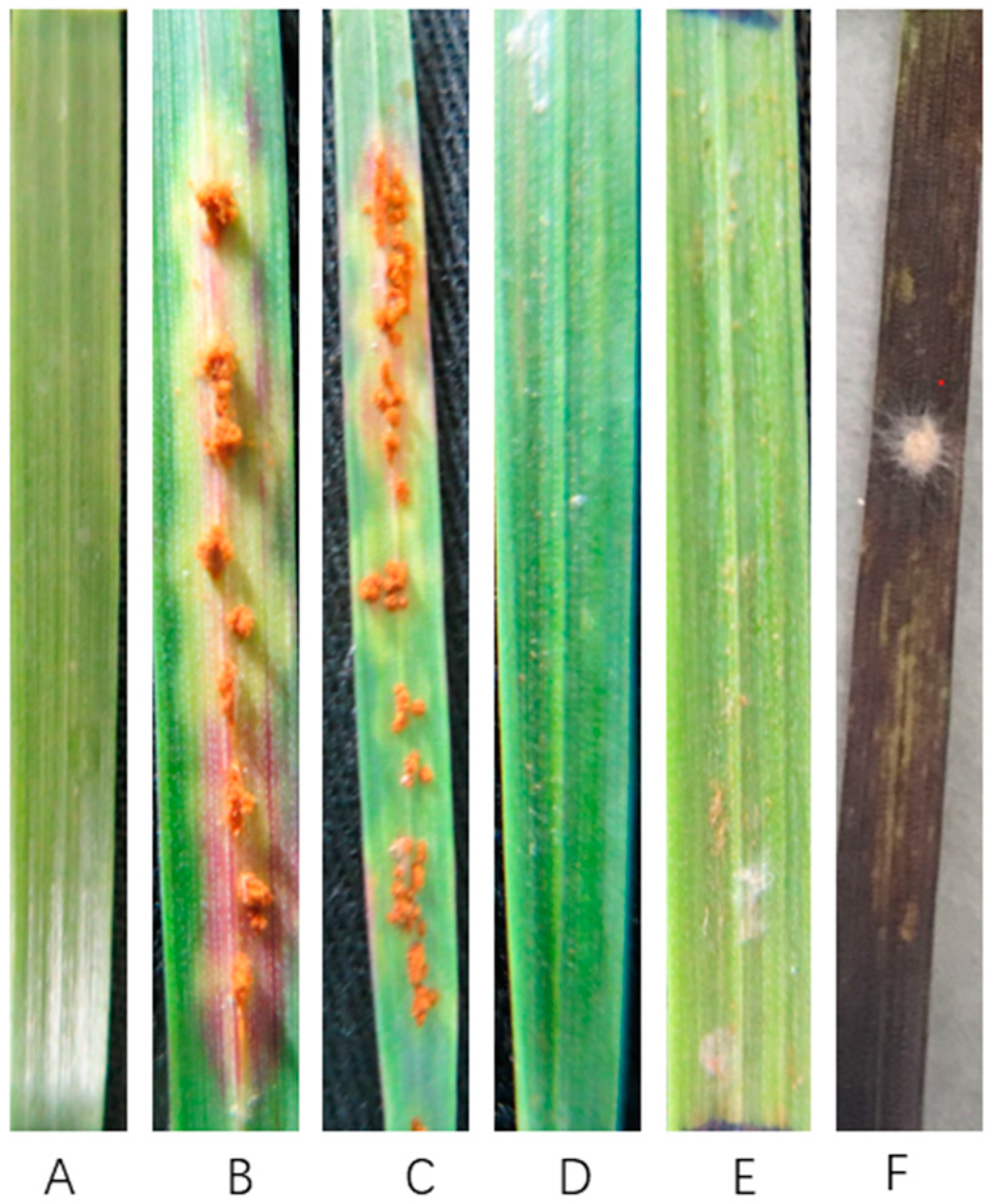
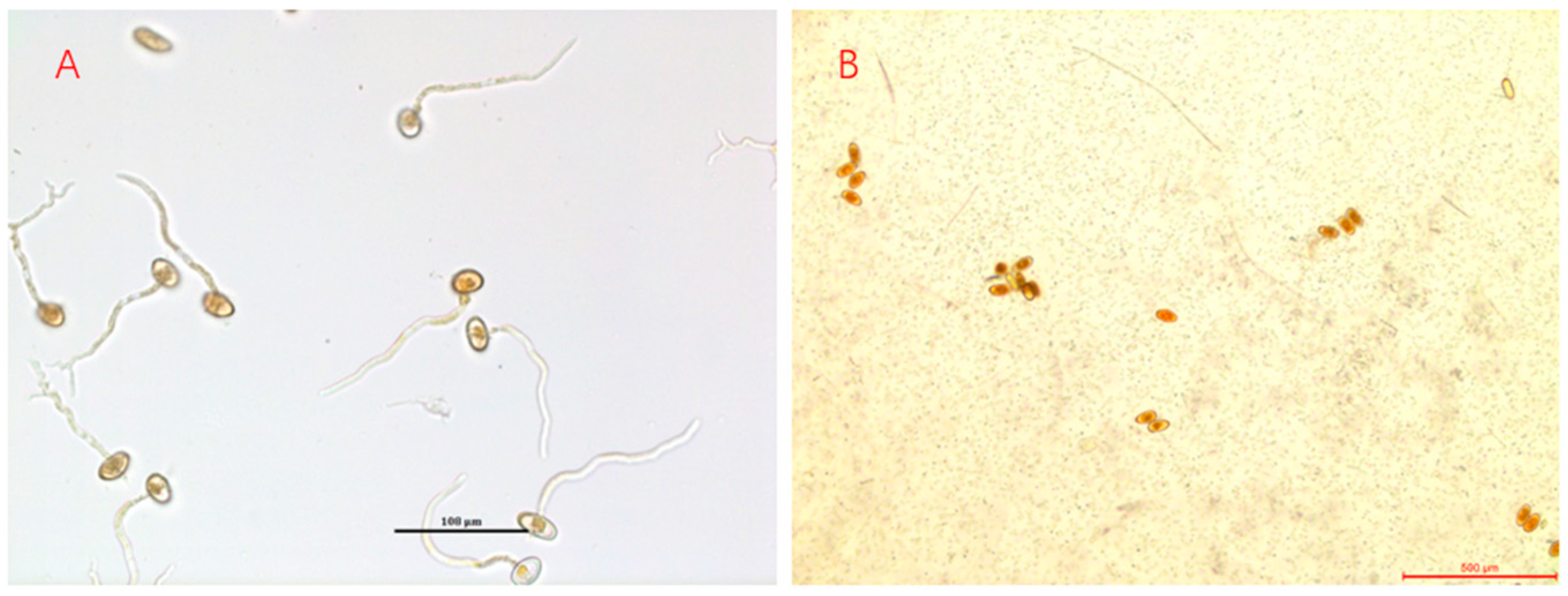
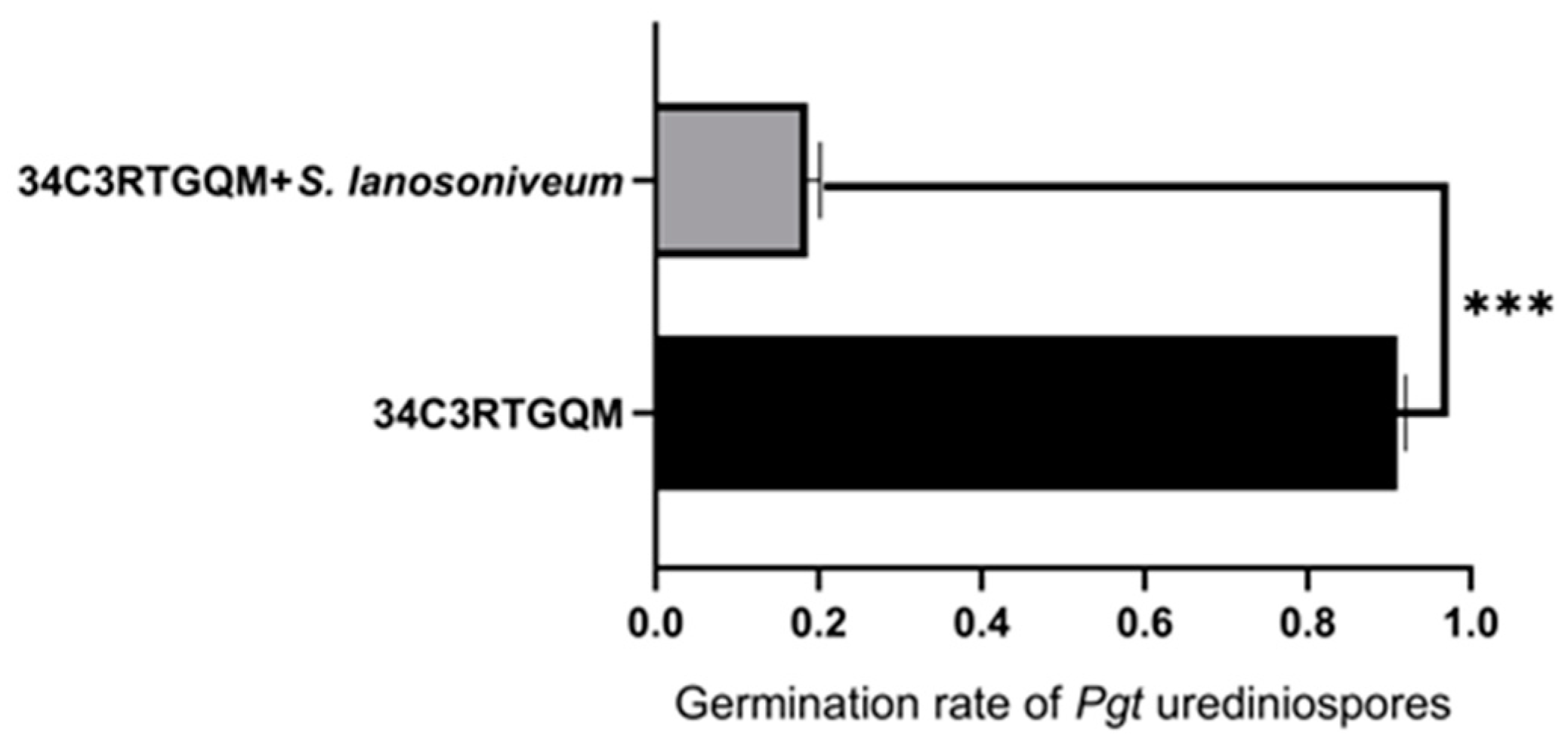

Disclaimer/Publisher’s Note: The statements, opinions and data contained in all publications are solely those of the individual author(s) and contributor(s) and not of MDPI and/or the editor(s). MDPI and/or the editor(s) disclaim responsibility for any injury to people or property resulting from any ideas, methods, instructions or products referred to in the content. |
© 2022 by the authors. Licensee MDPI, Basel, Switzerland. This article is an open access article distributed under the terms and conditions of the Creative Commons Attribution (CC BY) license (https://creativecommons.org/licenses/by/4.0/).
Share and Cite
Si, B.; Wang, H.; Bai, J.; Zhang, Y.; Cao, Y. Evaluating the Utility of Simplicillium lanosoniveum, a Hyperparasitic Fungus of Puccinia graminis f. sp. tritici, as a Biological Control Agent against Wheat Stem Rust. Pathogens 2023, 12, 22. https://doi.org/10.3390/pathogens12010022
Si B, Wang H, Bai J, Zhang Y, Cao Y. Evaluating the Utility of Simplicillium lanosoniveum, a Hyperparasitic Fungus of Puccinia graminis f. sp. tritici, as a Biological Control Agent against Wheat Stem Rust. Pathogens. 2023; 12(1):22. https://doi.org/10.3390/pathogens12010022
Chicago/Turabian StyleSi, Binbin, Hui Wang, Jiaming Bai, Yuzhen Zhang, and Yuanyin Cao. 2023. "Evaluating the Utility of Simplicillium lanosoniveum, a Hyperparasitic Fungus of Puccinia graminis f. sp. tritici, as a Biological Control Agent against Wheat Stem Rust" Pathogens 12, no. 1: 22. https://doi.org/10.3390/pathogens12010022
APA StyleSi, B., Wang, H., Bai, J., Zhang, Y., & Cao, Y. (2023). Evaluating the Utility of Simplicillium lanosoniveum, a Hyperparasitic Fungus of Puccinia graminis f. sp. tritici, as a Biological Control Agent against Wheat Stem Rust. Pathogens, 12(1), 22. https://doi.org/10.3390/pathogens12010022





